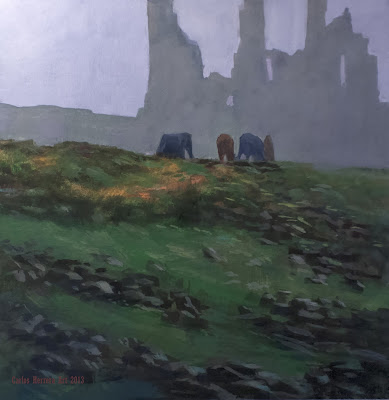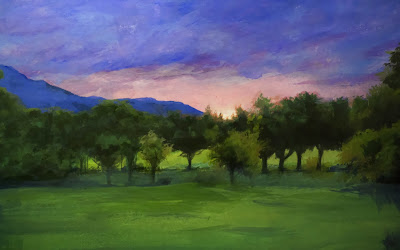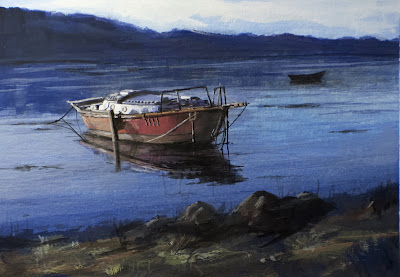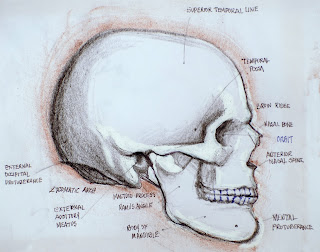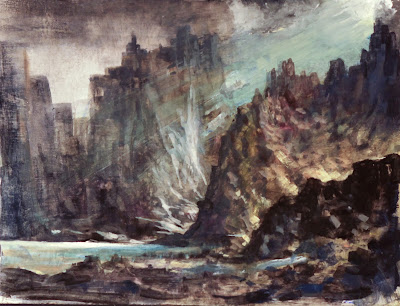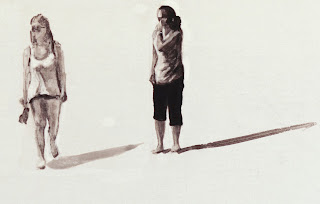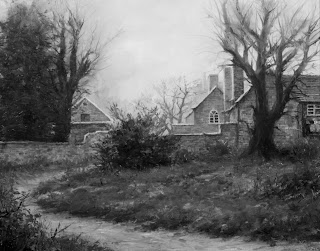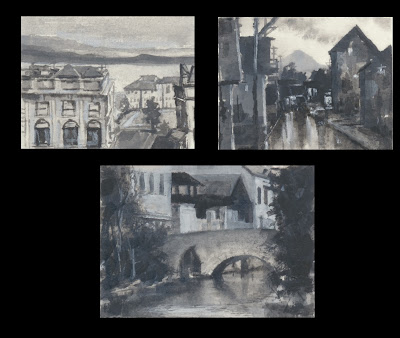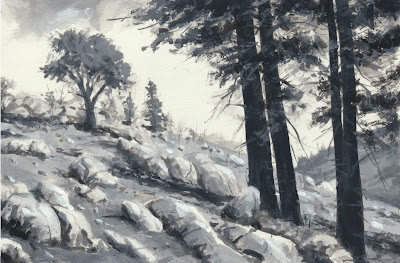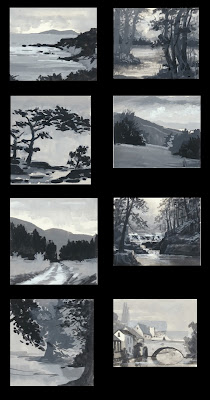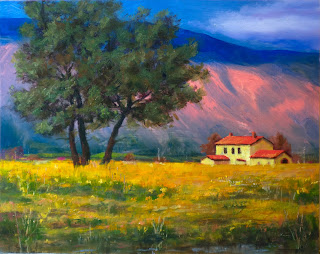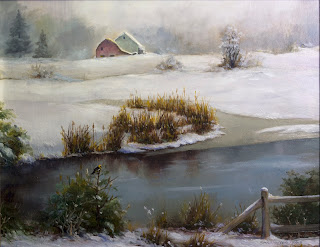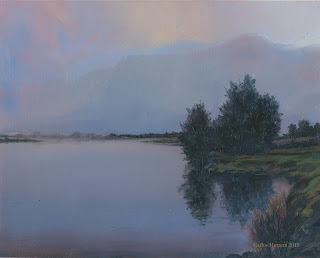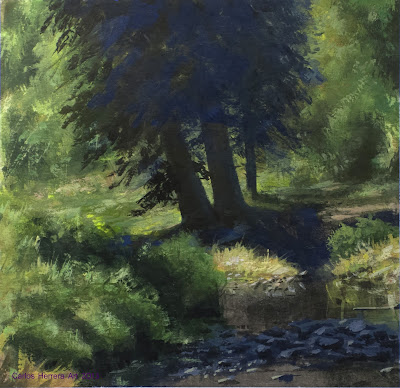 |
| Twin Brothers. |
Exploring Traditional and Digital Painting Techniques. Rebelle Featured Artist.
Tuesday, December 31, 2013
Saturday, December 28, 2013
Sunset from the Backyard
Thursday, December 26, 2013
Wednesday, December 25, 2013
Monday, December 23, 2013
Misty Farm Road
Saturday, December 21, 2013
Friday, December 20, 2013
Todays Painting
The challenge here was to render the foliage. Gouache on poster board sealed with white acrylic primer.
Dark Forest
4x5" Premium Tempera
Wednesday, December 18, 2013
Places in El Salvador
Tranferring a Charcoal Sketch to a Painting Surface
A common method for transferring a sketch to paper or
canvas is by rubbing charcoal on the back of the sketch, but charcoal dust gets
everywhere and the surface gets dirty. Here is a method I use when I am working
in gouache and oils.
Materials: Pure Powdered Charcoal General’s, vegetable
Glycerin, sharp hard pencil 4H, painting knife and a small soft sponge. I mixed the charcoal on my tempered glass palette as shown below:
Mix a few drops of glycerin with a small amount of charcoal, mix with a painting knife until the charcoal is completely wet. Apply mixture with the soft sponge to the back of sketch and let it dry for about three minutes. Carefully fix the sketch to the canvas; hold it in place with masking tape so it does not shift. Transfer the lines by going over the sketch with the hard pencil [a fine ball point will work well too.] Glycerin temporarily binds the charcoal to the paper and stops it from flying everywhere. The charcoal drawing will still come off so this is the time to trace it more permanently with dark [under-painting] acrylic, oils, etc depending on your painting technique.
This is the original sketch:
Glycerin dissolves in water and does not affect the subsequent application
of gouache, acrylic, watercolors or oils. This is how the charcoal, wet with glycerin, looks like
after applying it on the paper with the sponge:
This is how the transfer looks on poster boar covered with a
layer of acrylic primer [not gesso]. I believe this is a cleaner method.
Tuesday, December 17, 2013
Oil Paintings
Clouds Study
Here is a study of rain clouds on Canson canvas paper without gesso priming. I used Windsor & Newton Artisan oils. Canvas paper absorbs too much oil without gesso and the colors looked flat.
Rare rain
8x10"
Monday, December 16, 2013
Portrait of a Girl
Here a small oils monochrome painting in Raw Umber. Dahler Rowney Georgian .
Hope
6x8" Canson paper canvas.
Thursday, December 12, 2013
Gouache on Gessoed Canvas
Here is an example of a 6x8" landscape on canvas mounted on illustration board.
Hidden Creek
Dick Blick Premium Tempera
Imaginative Landscape
This is a small painting on poster board cover with two coats of gesso.
After the Storm.
Poster Paint. 3x4"
Wednesday, December 11, 2013
Brush Sketching
Gouache is similar to watercolor in
that both are water media but gouache's pigments are combined with chalk for opacity. With the addition of chalk, the ratio of pigments to arabic gum and water is much
higher than in watercolor. This makes gouache heavier and more opaque, with greater
reflective properties. One difficulty in mastering Gouache is that most of the time it dries to a different value than when it is wet. Dark colors dry lighter and light colors dry darker. This makes it difficult to control values in a painting. Nevertheless, gouache dries to a beautiful matte finish, is very durable, and dries very quickly.
In the sketches above I used gouache's range of possibilities from watercolor transparency all the way to very opaque. This time I used a direct approach - straight brushwork, without pencil sketching.
In the sketches above I used gouache's range of possibilities from watercolor transparency all the way to very opaque. This time I used a direct approach - straight brushwork, without pencil sketching.
Monday, December 9, 2013
Tonal Painting
If the painting works [e.i. has a balanced and pleasing tonal distribution] in black and white it will look fine in color.
German Village, 12x14". Oil on Canson Canvas Paper.
Here is another tonal painting of a village outside Rome, Italy.Friday, December 6, 2013
Rendering Architecture
Here a 4" x 5" study where more accurate architecture and the correct values of the buildings are essential.
Quiet Afternoon
Poster Tempera
Thursday, December 5, 2013
City Composition Stems
The amount of detail that a typical cityscape has makes harder to focus on rendering correct values. Here I used the values of the bridge as reference to determine the correct values of the surrounding houses. Painted with Black and White Dick Blick's Premium Tempera and Vegetable Glycerin.
Wednesday, December 4, 2013
Counterbalance or Steel Yard Composition Stem
This one is a little over 6" x 4". Here I attempted to capture more of the true light of the scene. To that effect I did not use pure black. Notice that the medium dark mass of the slop and the small trees on the left counterbalance the dark shapes of the foreground tree. This is a well tested successful composition format.
End of the Tree Line
Premium Tempera on hotpress watercolor paper
B & W Landscape Comps
Here is a set of landscape comps made with Dick Blick's Premium Tempera as a substitute for the much more expensive Lukas and Utrecht brands. I used hot-press watercolor paper as a surface.To slow down drying time I use Vegetable Glycerin USP 100% pure. Glycerin also helps tempera to stay flexible.
These compositions are no larger than 2" x 2-1/4". The comps show their relative size to one another.
Doing black and white composition allows me to understand the relative values, identify the best composition and potential problems in placement and size of the main elements. If the values are placed accurately, It also gives me an idea of the particular "light" of the landscape.
Gouache and Tempera, unpretentious as they are, are a very sophisticated media, capable of very fine detail. They also are a good stepping-stone toward learning to paint with oils.
Saturday, November 16, 2013
Painting on Polyester Canvas for InkJet Printer
This was painted on a piece of 8x10 in. Polyester canvas. Very nice surface to work on and of archival quality. Primed with Liquitex Basic Gesso.
Experimenting with Dick Blicks Premium Tempera - Poster Paint
Here are a few landscapes done in gouache and Dick Blick's Premium Tempera (Poster Paint). I am amazed at the quality and concentration of the pigments. Great for doing studies.
Subscribe to:
Posts (Atom)
